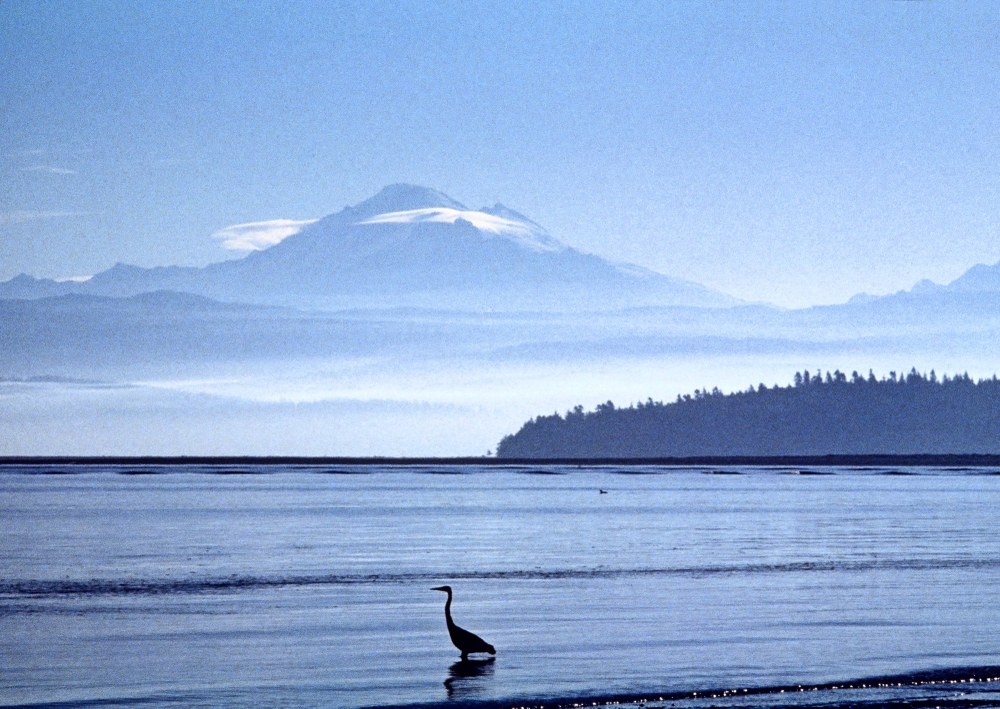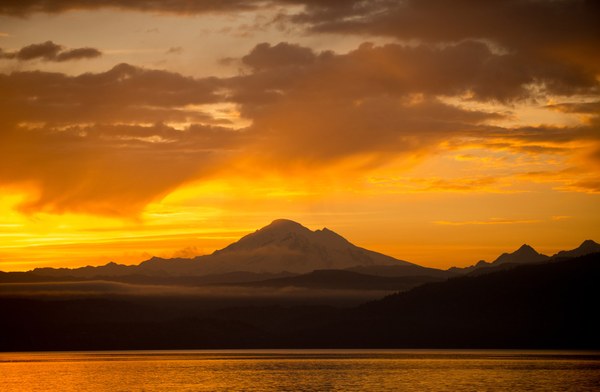
The Mountaineers is partnering with the Sacred Lands Conservancy, an Indigenous-led nonprofit with strong ties to the Lummi Nation, to produce a series of educational pieces on the importance of mindful recreation and how we can all develop deeper connections to the histories of our natural places. Tah-Mahs Ellie Kinley is a Lhaq’temish fisherwoman who has previously served as an elected member of Lummi Nation’s Fisheries and Natural Resource Commission. She is President of the Sacred Lands Conservancy. This final blog from her, written in collaboration with SLC’s Julie Trimingham, shares about the history and meaning of Indigenous place names with a focus on two of our region’s mountains.
– Conor Marshall, Advocacy & Engagement Manager
Mountains Come with Stories
Kw’elshàn was a handsome young man who had two wives: beautiful Clear Sky, and kind Fair Maiden. At first, Kw'elshán favored Clear Sky, who soon gave him three children. Eventually, Fair Maiden’s kindness won Kw'elshán's heart. This aroused Clear Sky's jealousy and she threatened to leave. Kw’elshán, too proud to give into his wife’s demands, called her bluff, so Clear Sky, also proud, made good on her threat and left. Every so often, she’d turn around and look, hoping that her husband would beckon her to return. Each time she did, she had to make herself taller so that she could see her husband and their children. Eventually she settled. At this point she was very, very tall and became Teqwúbe7 (tuckw-oo-buh): Mt. Rainier.
Kw'elshán and Fair Maiden then became pregnant, and Fair Maiden wished to give birth back at her mother’s home, so she traveled all the way down what later became the Nooksack River, all the way to the Salish Sea. There she lay down to rest and became what we now call Spieden Island, with her baby Sentinel Island resting beside her. Kw'elshán missed his wives dearly, so he made himself tall enough to see them, becoming Kw'eq Smánít (kwek smaneet; tall white mountain) today also known as Mt. Baker. His three children from Clear Sky also made themselves tall so they could also see their mother. Kw'etl' Kw'ítl' Smánit (kwet kweet smaneet; red mountains) and Chésqen (chucksun; golden eagle) are today known, respectively, as the Twin Sisters and Mt. Shuksan.
This story, as shared by Joshua Olsen, comes from Nooksack, whose people have forever lived along the Nooksack River and who have an intimate relationship with the northwestern slopes of the mountain now known as Baker. In Lhéchelesem, the Nooksack language, Joshua said, the names for the mountain are specific to place: the high meadows on the mountainside are Kwelshán, which translates to “shooting place” because it’s a traditional hunting ground. It was said that if you crossed the snow line to Kweq’ Smànit, a place of ice and rock, you’re not coming back.
Kwelshàn, the Xwlemi Chosen (Lummi language) name for the mountain, is the same as the Lhéchelesem but, according to Na’tak’ul’tan Tino Kurtz of Lummi, it means something more like “puncture wound,” a place that has been shot at. What is a volcanic vent like the one on Baker if not a puncture in the mountain’s skin? If you’re out on the islands that are traditional Lummi territory, you would certainly see the steam that this volcano occasionally puffs into the sky.
Mountains come with stories; names are tangled with meaning. Indigenous place names carry physical descriptions, information about resources, stories both practical and sacred. They may indicate traveling routes, territories, layered histories. Stories reflect perspective and relationship to a place. From village to village, the dialects, the stories, the names all shift as the view of the mountain changes.
Creation is a Love Story
A long time ago, there were two villages. They were close enough to walk one to the other. A young man from one village fell in love with a young woman from the other, but their parents forbade their union. The lovers planned to run away together, but they were found out. The villages were in an uproar about this disobedience and went to war, throwing mud and rock and saltwater beach at each other. All this mud and rock created the islands in the Salish Sea. Creator stepped in and said, “We can’t have this fighting.” He said the two lovers would be kept separate to remind the villages of the violence done to the land. The woman became the mountain now known as Baker and the man became the mountain now known as Rainier. But Creator is never cruel. On a clear day, the mountains can see each other. Rainier is still courting his beloved Baker, sometimes wearing his cedar hat (the cloud cap).
This is the backbone of the story as told by tsi sqwal alqwal Lora Pennington, of Upper Skagit, whose people live south of Mt. Baker, north of Rainier. In Lushootseed, the language spoken by many tribes around the Salish Sea, both mountains bear the name təqʷuba, but the pronunciation differs: one indicates “to the north,” and the other “to the south.”
Teqwúbe7, təqʷuba, Te-kómeh become, in English, Tahoma, Tacoma: each can each refer to “any snow-capped mountain,” though Mt. Rainier often wears that name. Again, it depends on the speaker, the storyteller, and their relationship to the mountain. No matter what the name, though, these regional stories share a thread: creation is a love story. The mountains, the islands, the waters are all in dynamic, kinship relation to one another.
 Kwelshàn (Mount Baker) at Sunrise. Photo by Sharon Eva Grainger - Photographer.
Kwelshàn (Mount Baker) at Sunrise. Photo by Sharon Eva Grainger - Photographer.
Understanding the Concept of Territory
Back when oral tradition was the way knowledge was shared, before things were fixed on paper or in pixels, before nation-states drew lines across the land, there was flexibility in the idea of territory. Territory was where you lived: where you fished, hunted, foraged, harvested, gathered, sang, danced. Territory encompassed a multitude of purposes and seasonal migrations. Territory was where your sacred sites and stories were. Villages in a particular region would be in relationship to one another by language, culture, and kinship ties. Territories - like language and stories - overlapped; there were protocols for borderlands and passage.
Your mountain and your river and your islands were yours not because you owned them, but because you were in respectful, reciprocal relationship with them. You needed to understand the seasons and resources and dangers of a place in order to survive. You witnessed their beauty and wondrousness and change through the seasons. The places were yours because you were theirs, in the way that family members belong to each other.
Here is another story about a mountain: On April 30, 1792, Joseph Baker, third Lieutenant, stood aboard the HMS Discovery, a full-rigged Royal Navy tall ship under the command of George Vancouver. They were moored at what is now called Admiralty Inlet, in between Whidbey Island and the Kitsap Peninsula. Up on deck, gazing in a northeasterly direction, Lieutenant Baker saw a mountain. Perhaps the Lieutenant pointed at it, or exclaimed something like, “Look at the pretty mountain!” At any rate, Vancouver thought that since Baker was the “first” person to see the mountain, it should be named after him.
By mapping the coastline and naming the islands, the mountains, the waterways, did Vancouver believe he was - like Adam naming animals in the Garden of Eden - establishing claim? Vancouver and Baker were men raised to believe they had dominion over everything. When a name is used to claim, we lose so much good information. Yes, we learn - maybe - something about imperialism or history, but we don’t learn about the mountain itself, or our lived relationship to it.
The mountains, deserts, fields, forests, waterways, monumental rocks, and wildflower prairies all across Turtle Island were once called by names of the people who had generational experience of these places. Many Indigenous names remain, but often the meanings and stories have been lost, or remain hidden.
Honoring the Spirit of Our Special Places
Indigenous place names recognize and reaffirm our histories and ongoing relationships to our places. Learning original names and stories of the places that hold your heart can deepen your love and understanding of the land. Some resources are available via the references listed below.
There are movements now to restore some Indigenous place names as a way of acknowledging historical and ongoing Indigenous presence, as well as acknowledging the features, resources, stories, and sanctity of the land itself. Reviving ancient names can be one step beyond land acknowledgement, part of the ongoing process of decolonization. Because names often contain cultural knowledge, it’s important that the Indigenous holders of this knowledge be the leaders in re-naming efforts, if the effort is undertaken at all.
When Joshua Olsen spoke about Kw’elshàn, he said that name was “like the man who became the mountain.” Kw’elshàn was tall, good looking, and proud. He had two wives. In a mountain that is somehow like a man, there is personhood, agency. The mountain has a spirit.
These stories and names can teach us that spirit animates every mountain, every river, every forest, every sea. Recognizing the spirit of a place allows us to relate to it, to be in kinship relationship. The mountains and the islands are family to one another, and to us. We are all part of this family, and we are all children of our living Mother Earth. Seeing the spirit in the place reminds us that our obligation to caretake all our relations, including our mountains, is sacred.
Notes & Sources
- Native stories are long and complex. The versions shared here are distillations, and do not represent the stories in their entirety. Also, there is a lot that does not translate into English.
- Joshua Olsen is a member of the Nooksack Indian Tribe, and is the Nooksack cultural liaison for the Whatcom County Library System. He studies Lhéchelesem under George Adams. Joshua says that “Language influences thoughts and beliefs and ways of thinking and is a cornerstone of Indigenous Sovereignty.”
- Na’tak’ul’tan Tino Kurtz is a speaker of Xwlemi Chosen, the Lummi language, and works in the Cultural Resources Department of Lummi Nation. He is the translator of“Sa’le Q’ewet Netse’lh / Our Hearts Beat as One,” a bilingual Xwlemi Chosen / English children’s book about the captive orca known as Sk’aliCh’elh-tenaut / Tokitae / Lolita.
- tsi sqwal alqwal Lora Pennington is a member of the Upper Skagit Tribe, a weaver, and a student of Lushootseed, the language of her people.
- This piece has been informed by — and according to Joshua Olsen, Nooksack language revitalization has been tremendously aided by — the work of Allan Richardson and Brent Galloway, and their book Nooksack Place Names: Geography, Culture, and Language, published by the University of British Columbia Press. Richardson, A. and Lloyd, T. A. (2014).
- From the Monument Lab: Place names as Monuments: the Entangled Histories of Coaquannock and Philadelphia.
- From the Geographical Names Board of Canada: Stories from the Land: Indigenous Place Names in Canada.
- From the University of Maine: Coming Home to Indigenous Place Names: this map depicts Indigenous place names across Canada, shared by permission of First Nations, Métis, and Inuit communities and people.
We are grateful for the opportunity to share these stories and perspectives. Read more content from Sacred Lands Conservancy on our Honoring Native Lands and Peoples page.
Add a comment
Log in to add comments.Thank you for sharing this information and providing a comparison between the meaning of indigenous names vs. colonizers. The U.S. has recently made progress in replacing names that are derogatory toward indigenous tribes. I hope that one day we will make progress in replacing colonial names with ones that reflect a respect and love of the land.
 Sacred Lands Conservancy with Tah-Mahs Ellie Kinley
Sacred Lands Conservancy with Tah-Mahs Ellie Kinley